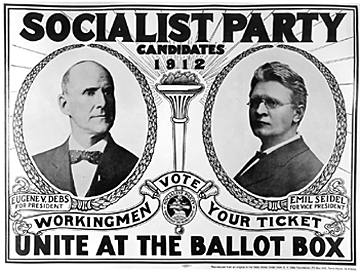 “Socialist administrations were most often elected in small or medium-sized railroad, mining, or industrial centers. Where the worker was not a worker or trade unionist himself, others in the administration often were. In Butte, Montana, the Socialist mayor was a minister; the police judge and city treasurer elected with him in 1911 were miners. In Lackawanna, New York where a socialist mayor (occupation unknown) was elected in 1919, the two Socialist councilmen were trade unionists. Similarly in Davenport, Iowa, which elected a Socialist doctor to the mayoralty in 1920, the Socialist city clerk was a machinist. Continue reading
“Socialist administrations were most often elected in small or medium-sized railroad, mining, or industrial centers. Where the worker was not a worker or trade unionist himself, others in the administration often were. In Butte, Montana, the Socialist mayor was a minister; the police judge and city treasurer elected with him in 1911 were miners. In Lackawanna, New York where a socialist mayor (occupation unknown) was elected in 1919, the two Socialist councilmen were trade unionists. Similarly in Davenport, Iowa, which elected a Socialist doctor to the mayoralty in 1920, the Socialist city clerk was a machinist. Continue reading
Tag Archives: James Weinstein
American Socialism, Strongest West of the Mississippi
 “Before the World War, American socialism was diffuse geographically as well as in its tendencies. Until 1918 the greatest relative voting strength of the movement lay west of the Mississippi River, in the states where mining, lumbering, and tenant farming prevailed. New York, since 1917 the bastion of socialism in the United States, placed 29th and 24th in the percentage of Socialist votes in 1912 and 1916. Even in New York, the Party’s greatest strength was upstate. Until 1917, Schenectady was the Socialist stronghold, electing the Reverend George R. Lunn as mayor in 1911 and 1915, and sending a Socialist to the state assembly in 1911. The states with the greatest percentages of Socialist voters in the prewar years were Oklahoma, Nevada, Montana, Washington, California, Idaho, Florida, Arizona, Wisconsin, and Texas. In that order, all appeared among the top dozen states in the presidential elections of both 1912 and 1916. Oklahoma had the largest and most complete organization: 12,000 Party members in 961 locals, 38,000 subscribers to the Appeal to Reason, 53,000 Socialist voters in the state in 1914. In that year, five Socialists were elected to the Oklahoma assembly and one to the state senate, along with more than 130 Socialist county and township officers.
“Before the World War, American socialism was diffuse geographically as well as in its tendencies. Until 1918 the greatest relative voting strength of the movement lay west of the Mississippi River, in the states where mining, lumbering, and tenant farming prevailed. New York, since 1917 the bastion of socialism in the United States, placed 29th and 24th in the percentage of Socialist votes in 1912 and 1916. Even in New York, the Party’s greatest strength was upstate. Until 1917, Schenectady was the Socialist stronghold, electing the Reverend George R. Lunn as mayor in 1911 and 1915, and sending a Socialist to the state assembly in 1911. The states with the greatest percentages of Socialist voters in the prewar years were Oklahoma, Nevada, Montana, Washington, California, Idaho, Florida, Arizona, Wisconsin, and Texas. In that order, all appeared among the top dozen states in the presidential elections of both 1912 and 1916. Oklahoma had the largest and most complete organization: 12,000 Party members in 961 locals, 38,000 subscribers to the Appeal to Reason, 53,000 Socialist voters in the state in 1914. In that year, five Socialists were elected to the Oklahoma assembly and one to the state senate, along with more than 130 Socialist county and township officers.

“In 1911, four years after statehood, Oklahomans adopted their first flag. Flying above our State Capitol was a bright red plane emblazoned with a single, centered, white star, emblematic of leftist flags flown first in 18th century France and contemporary to those of Russia and China during the Communist Revolution.” — Derek Dyson
Why Is There No Mass-Based American Socialist Movement?
“Everybody recognizes the United States as the only industrialized nation in the world with no significant movement for socialism. Since World War II, most Americans have come to assume that this has always been so, for not only in the affluent post-war years but even during the Great Depression (when American capitalism had collapsed and could revive itself only with the start of arms production for another world war), the idea of socialism remained the property of small and isolated groups. The reasons for this are also well known. They include the high American standard of living, the impact of free land and unique class mobility in a society with no feudal past, and the speed and ease with which sophisticated liberals, starting with Theodore Roosevelt, have been able to appropriate enough of the left’s demands to capture a good part of a potential socialist following. Then, too, the United States, being an immigrant nation, has been as sharply divided along lines of race and national origin as along those of class. Suppression of leftists and of their right to speak, removal of socialist publications from the mails, harassment of socialist organizations and prosecution of their leaders by federal, state, and local governments have also weakened the left. Continue reading